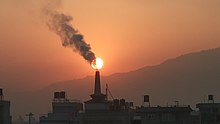Our website is made possible by displaying online advertisements to our visitors.
Please consider supporting us by disabling your ad blocker.
Particulates


| Part of a series on |
| Pollution |
|---|
 |
Particulates or atmospheric particulate matter (see below for other names) are microscopic particles of solid or liquid matter suspended in the air. The term aerosol refers to the particulate/air mixture, as opposed to the particulate matter alone,[1] though it is sometimes defined as a subset of aerosol terminology.[2] Sources of particulate matter can be natural or anthropogenic.[3] They have impacts on climate and precipitation that adversely affect human health, in ways additional to direct inhalation.
Types of atmospheric particles include suspended particulate matter; thoracic and respirable particles;[4] inhalable coarse particles, designated PM10, which are coarse particles with a diameter of 10 micrometers (μm) or less; fine particles, designated PM2.5, with a diameter of 2.5 μm or less;[5] ultrafine particles, with a diameter of 100 nm or less; and soot.
Airborne particulate matter is a Group 1 carcinogen.[6] Particulates are the most harmful form (other than ultra-fines) of air pollution[7] as they can penetrate deep into the lungs and brain from blood streams, causing health problems such as heart disease, lung disease, cancer and preterm birth.[8] There is no safe level of particulates. Worldwide, exposure to PM2.5 contributed to 4.1 million deaths from heart disease, stroke, lung cancer, chronic lung disease, and respiratory infections in 2016.[9] Overall, ambient particulate matter is one of the leading risk factor for premature death globally.[10]
- ^ Seinfeld J, Pandis S (1998). Atmospheric Chemistry and Physics: From Air Pollution to Climate Change (2nd ed.). Hoboken, New Jersey: John Wiley & Sons. p. 97. ISBN 978-0-471-17816-3.
- ^ Aerosol Measurement: Principles, Techniques, and Applications. Wiley. October 2001. ISBN 978-0-471-35636-3.
- ^ Plainiotis S, Pericleous KA, Fisher BE, Shier L (January 2010). "Application of Lagrangian particle dispersion models to air quality assessment in the Trans-Manche region of Nord-Pas-de-Calais (France) and Kent (Great Britain)" (PDF). International Journal of Environment and Pollution. 40 (1/2/3): 160–74. doi:10.1504/IJEP.2010.030891.
- ^ Brown JS, Gordon T, Price O, Asgharian B (April 2013). "Thoracic and respirable particle definitions for human health risk assessment". Particle and Fibre Toxicology. 10 (1): 12. Bibcode:2013PFTox..10...12B. doi:10.1186/1743-8977-10-12. PMC 3640939. PMID 23575443.
- ^ US EPA, OAR (19 April 2016). "Particulate Matter (PM) Basics". US EPA. Archived from the original on 29 September 2023. Retrieved 5 October 2019.
- ^ "EHP – Outdoor Particulate Matter Exposure and Lung Cancer: A Systematic Review and Meta-Analysis". ehp.niehs.nih.gov. Archived from the original on 29 May 2016. Retrieved 29 December 2016.
- ^ Wasley, Andrew; Heal, Alexandra; Harvey, Fiona; Lainio, Mie (13 June 2019). "Revealed: UK government failing to tackle rise of serious air pollutant". The Guardian. Archived from the original on 13 June 2019. Retrieved 14 June 2019.
- ^ Thangavel, Prakash; Park, Duckshin; Lee, Young-Chul (19 June 2022). "Recent Insights into Particulate Matter (PM2.5)-Mediated Toxicity in Humans: An Overview". International Journal of Environmental Research and Public Health. 19 (12): 7511. doi:10.3390/ijerph19127511. ISSN 1660-4601. PMC 9223652. PMID 35742761.
- ^ "STATE OF GLOBAL AIR/2018 A SPECIAL REPORT ON GLOBAL EXPOSURE TO AIR POLLUTION AND ITS DISEASE BURDEN" (PDF). Health Effects Institute. 2018. Archived (PDF) from the original on 22 April 2018. Retrieved 7 September 2018.
- ^ "The Weight of Numbers: Air Pollution and PM2.5". Undark. Archived from the original on 7 September 2018. Retrieved 6 September 2018.
Previous Page Next Page


